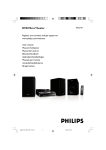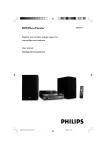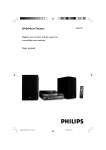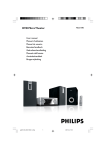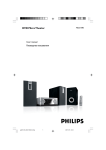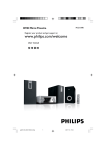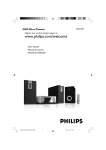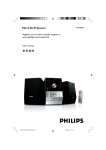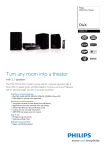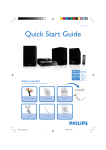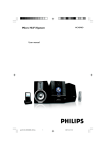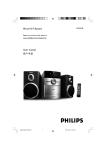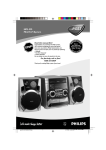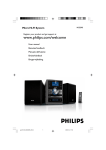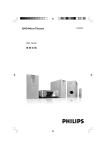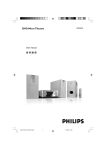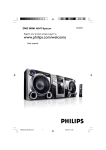Download Philips MCD179 DivX DVD Micro Theater
Transcript
Register your product and get support at
www.philips.com/welcome
pg001-020_MCD179_58_Eng
1
3/27/08, 15:32
Manufactured under license from Dolby
Laboratories. Dolby and the double-D symbol
are trademarks of Dolby Laboratories.
CONSUMERS SHOULD NOTE THAT NOT ALL
HIGH DEFINITION TELEVSION SETS ARE FULLY
COMPATIBLE WITH THIS PRODUCT AND MAY
CAUSE ARTIFACTS TO BE DISPLAYED IN THE
PICTURE. IN CASE OF 525 OR 625 PROGRESSIVE
SCAN PICTURE PROBLEMS, IT IS RECOMMENDED THAT THE USER SWITCH THE
CONNECTIN TO THE ‘STANDARD DEFINITION’
OUTPUT. IF THERE ARE QUESTIONS REGARDING OUR TV SET COMPATIBILITY WITH THIS
MODEL 525p AND 625p DVD PLAYER, PLEASE
CONTACT OUR CUSTOMER SERVICE CENTER.
DivX Certified products: “DivX Certified, and
associated logos are trademarks of DivX, Inc. and
are used under license.
Windows Media and the Windows logo are
trademarks, or registered trademarks of
Microsoft Corporation in the United States and/
or other countries.
This product incorporates copyright protection
technology that is protected by method claims of
certain U.S. patents and other intellectual
property rights owned by Macrovision
Corporation and other rights owners. Use of this
copyright protection technology must be
authorized by Macrovision Corporation, and is
intended for home and other limited viewing
uses only unless otherwise authorized by
Macrovision Corporation. Reserve engineering
or disassembly is prohibited.
2
pg001-020_MCD179_58_Eng
2
3/27/08, 15:32
êÛÒÒÍËÈ --------------------------------------------------------- 41
3
pg001-020_MCD179_58_Eng
3
3/27/08, 15:32
Р ус с к и й
English ------------------------------------------------ 4
English
Index
Contents
English
General Information
Disc Operations
Features .................................................................. 6
Supplied accessories ............................................ 6
Environmental information ................................ 6
Safety information ............................................ 6~7
Maintenance .......................................................... 7
Hearing Safety ....................................................... 7
Playable Discs ...................................................... 21
Region Codes ...................................................... 21
Playing discs ......................................................... 22
Using the Disc Menu ......................................... 22
Resuming playback ............................................. 22
Selecting and searching .............................. 22~23
Selecting a different track/chapter
Fast forwarding/reversing
Slow forwarding/reversing
Different play modes: REPEAT, SHUFFLE and
REPEAT A-B ......................................................... 23
REPEAT
Repeat A-B
Programming favourite chapters/tracks ........ 24
Display information ............................................ 24
Moving to another title/chapter ..................... 24
Viewing from another angle ............................. 25
ZOOM .................................................................. 25
AUDIO ................................................................. 25
SUBTITLE ............................................................. 25
Playing MP3/Picture disc (Kodak, JPEG) . 25~26
Playing MP3 music and JPEG pictures
simultaneously ..................................................... 26
Playing a Divx disc .............................................. 27
Connections
Step 1: Placing speakers and subwoofer .......... 8
Step 2: Connecting speakers and subwoofer . 8
Step 3: Connecting TV set ........................... 9~10
Using Video In jack (CVBS)
Using Headphone jack
Using component Video In jack (Pr Pb Y)
Using S-Video In jack
Using an accessory RF modulator
Step 4: Connecting the FM antenna ............... 11
Step 5: Connecting the power cord ............... 11
Step 6: Connecting a VCR or cable/satellite box
................................................................................ 11
Step 7: Connecting digital audio equipment . 12
Step 8: Connecting portable audio player .... 12
Functional Overview
Controls on the system .................................... 13
Remote control ........................................... 14~15
Getting Started
Step 1: Using the Remote Control ................. 16
Step 2: Setting up the TV ........................... 16~18
Selecting the color system that matches your
TV set
Setting up Progressive Scan feature (for
Progressive Scan TV only)
To deactivate Progressive manually
Step 3: Setting language preference ................ 18
Setting the OSD Language
Setting the Audio, Subtitle and Disc Menu
language
Basic Operations
Plug and Play (for tuner installlation) ........................ 19
Switching the system on/off ............................. 19
Power saving automatic standby ..................... 19
Volume control ................................................... 20
Sound Control .................................................... 20
DBB (Dynamic Bass Boost)
DSC (Digital Sound Control)
LOUDNESS
System Menu Options
Basic operations ................................................. 28
General Setup Page ............................................ 28
OSD Lang
Screen Saver
DIVX VOD
Audio Setup Page ........................................ 28~29
Night Mode
Digital Output
Dolby Digital Setup
Video Setup Page ......................................... 29~30
TV Display
Progress
TV Type
Preference Page ........................................... 30~31
Audio
Subtitle
Disc Menu
Parental
Password
Divx Subtitle
Default
4
pg001-020_MCD179_58_Eng
4
3/27/08, 15:32
English
Contents
Radio Reception
Tuning to radio stations .................................... 32
Programming radio station .............................. 32
Automatic programming
Manual programming
Tuning to preset radio stations ....................... 32
USB Connection
Using USB connectivity .............................. 33~34
Clock/Timer
Viewing clock ...................................................... 35
Setting clock ........................................................ 35
Setting wake-up timer ....................................... 35
Setting sleep timer ............................................. 35
Specifications ........................................... 36
Troubleshooting ............................. 37~39
Glossary ......................................................... 40
5
pg001-020_MCD179_58_Eng
5
3/27/08, 15:32
General Information
English
Congratulations on your purchase and
welcome to Philips!
To fully benefit from the support that Philips
offers, register your product at
www.philips.com/welcome.
This product complies with the radio
interference requirements of the European
Community.
Features
Your DVD MICRO THEATRE System with 2.1channel full analog amplifier creates the same
dynamic sound qualities that you find in full
fledged cinemas and incorporates some of the
best features in home theater technology. Other
features include:
Additional Component Connections
Lets you connect other audio and audio/visual
components to the DVD micro system.
Parental Control (Rating Level)
Lets you set a ratings level so that your children
cannot watch a DVD that has a rating higher
than you set.
Sleep/Wake-up Timer
Enables the system to switch on/off automatically
at a preset time.
Progressive Scan
Provides high quality flicker-free images for film
based sources. When a picture refreshes, its
vertical resolution can double to 525 lines.
Note:
– To fully enjoy the progressive scan feature, you
need a progressive scan TV.
Supplied accessories
–
–
–
–
–
–
–
Remote control with one CR2025 battery
Two speakers and one subwoofer
DIN cable
A/V cable (yellow/red/white)
Component cable (red/green/blue)
FM wire antenna
User Manual and Quick Start Guide
If any item is damaged or missing, contact
your retailer or Philips.
Environmental information
All unnecessary packaging has been omitted. We
have tried to make the packaging easy to
separate into three materials: cardboard (box),
polystyrene foam (buffer) and polyethylene (bags,
protective foam sheet).
Your system consists of materials which can be
recycled and reused if disassembled by a
specialised company. Please observe the local
regulations regarding the disposal of packaging
materials, exhausted batteries and old
equipment.
Disposal of your old product
Your product is designed and
manufactured with high quality
materials and components, which
can be recycled and reused.
When this crossed-out wheeled
bin symbol is attached to a
product it means the product is
covered by the European Directive 2002/96/EC
Please inform yourself about the local separate
collection system for electrical and electronic
products.
Please act according to your local rules and do
not dispose of your old products with your
normal household waste. The correct disposal of
your old product will help prevent potential
negative consequences for the environment and
human health.
Safety information
● Before operating the system, check that the
operating voltage indicated on the typeplate (or
the voltage indication beside the voltage
selector) of your system is identical with the
voltage of your local power supply. If not, please
consult your dealer.
● Where the MAINS plug or an appliance coupler
is used as the disconnet device, the disconnect
device shall remain readily operable.
● Place the system on a flat, hard and stable
surface.
● The apparatus shall not be exposed to
dripping or splashing.
● Install the unit near the AC outlet and where the
AC power plug can be easily reached.
6
pg001-020_MCD179_58_Eng
6
3/27/08, 15:32
● Place the system in a location with adequate
ventilation to prevent internal heat build-up in
your system. Allow at least 10 cm (4 inches)
clearance from the rear and the top of the unit
and 5 cm (2 inches) from each side.
● The ventilation should not be impeded by
covering the ventilation openings with items,
such as newspapers, table-cloths, curtains, etc.
● Do not expose the system, batteries or discs to
excessive moisture, rain, sand or heat sources
caused by heating equipment or direct sunlight.
English
General Information
● The lens may cloud over when the player is
suddenly moved from cold to warm
surroundings, making it impossible to play a disc.
Leave the player in the warm environment until
the moisture evaporates.
Hearing Safety
Listen at a moderate volume.
● No objects filled with liquids, such as vases, shall
be placed on the apparatus.
● Using headphones at a high volume can impair
your hearing. This product can produce sounds
in decibel ranges that may cause hearing loss for
a normal person, even for exposure less than a
minute. The higher decibel ranges are offered
for those that may have already experienced
some hearing loss.
● If the system is brought directly from a cold to a
warm location, or is placed in a very damp room,
moisture may condense on the lens of the disc
unit inside the system. Should this occur, the CD
player would not operate normally. Leave the
power on for about one hour with no disc in the
system until normal playback is possible.
● Sound can be deceiving. Over time your hearing
"comfort level" adapts to higher volumes of
sound. So after prolonged listening, what sounds
"normal" can actually be loud and harmful to
your hearing. To guard against this, set your
volume to a safe level before your hearing
adapts and leave it there.
● No naked flame sources, such as lighted candles,
should be placed on the apparatus.
● The mechanical parts of the set contain selflubricating bearings and must not be oiled or
lubricated.
● Batteries (battery pack or batteries installed)
shall not be exposed to excessive heat such as
sunshine, fire or the like.
● When the system is switched to Standby
mode, it is still consuming some power.
To disconnect the system from the
power supply completely, remove the AC
power plug from the wall socket.
Maintenance
To establish a safe volume level:
● Set your volume control at a low setting.
● Slowly increase the sound until you can hear it
comfortably and clearly, without distor tion.
Listen for reasonable periods of time:
● Prolonged exposure to sound, even at normally
"safe" levels, can also cause hearing loss.
● Be sure to use your equipment reasonably and
take appropriate breaks.
Be sure to observe the following
guidelines when using your headphones.
● When a disc becomes dirty,
clean it with a cleaning cloth.
Wipe the disc from the center
out, in a straight line.
● Do not expose the player,
batteries or discs to humidity,
rain, sand or excessive heat
(caused by heating equipment or direct sunlight).
Always keep the disc tray closed to avoid dust
on the lens.
● Do not use solvents such as benzene, thinner,
commercially available cleaners, or anti-static
spray intended for colour discs.
● Listen at reasonable volumes for reasonable
periods of time.
● Be careful not to adjust the volume as your
hearing adapts.
● Do not turn up the volume so high that you
can't hear what's around you.
● You should use caution or temporarily
discontinue use in potentially hazardous
situations.
● Do not use headphones while operating a
motorized vehicle, cycling, skateboarding, etc.; it
may create a traffic hazard and is illegal in many
areas.
7
pg001-020_MCD179_58_Eng
7
3/27/08, 15:32
Connections
English
Step 1:
Placing speakers and
subwoofer
Step 2:
Right speaker
Connecting speakers
and subwoofer
Subwoofer
Y
For best possible surround sound, locate your
speakers and subwoofer as follows:
● Place the left and right speakers at equal
distances from the TV set and at an angle of
approximately 45 degrees from the listening
position.
● Place the subwoofer on the floor.
PB
Left speaker
PR
● Connect the supplied DIN cable to DVD player’s
DIN jack and the subwoofer’s DIN jack.
● Connect the speaker wires to the SPEAKER
terminals, right speaker to "R" and left speaker to
"L", coloured (marked) wire to "+" and black
(unmarked) wire to "-". Fully inser t the stripped
portion of the speaker wire into the terminal as
shown.
Notes:
– To avoid magnetic interference, position the
speakers, subwoofer as far as possible from the
main unit,TV set or other radiation source.
– Allow adequate ventilation around the DVD
System.
IMPORTANT!
The type plate is located on the bottom
of the system.
To avoid overheating of the system, a
safety circuit has been built in. Therefore,
your system may switch to Standby
mode automatically under extreme
conditions. If this happens, let the system
cool down before reusing it.
Notes:
– For optimal sound performance, use the
supplied speakers.
– Do not connect more than one speaker to any
one pair of +/- speaker terminals.
– Do not connect speakers with an impedance
lower than the speakers supplied. Please refer to
the SPECIFICATIONS section of this manual.
8
pg001-020_MCD179_58_Eng
8
3/27/08, 15:32
Step 3:
Connecting TV set
IMPORTANT!
– You only need to make one video
connection from the following options,
according to the capabilities of your TV
system.
– S-Video or Component Video
connection provides higher picture
quality. These options must be available
on your TV set.
– Connect the system directly to the TV
set.
Using Video In jack (CVBS)
IN
Y
PB
English
Connections
Using Headphone jack
Y
PB
PR
● To listen to TV through this system, use a cinch
cable (not supplied) to connect AUX IN jack
(3.5mm) to the HEADPHONE jack on the TV
set (with a 3.5mm-diameter stereo jack).
Or, you may use a cinch calbe (not supplied) to
connect AUX IN jack (3.5mm) to audio out
jacks on the TV set.
PR
● Use the supplied composite video cable (yellow)
to connect the system’s COMPOSITE
VIDEO jack to the video input jack (or labeled
as A/V In, Video In, Composite or Baseband) on
the TV set.
● To hear the sound of this DVD Player through
your TV, use the audio cables (white/red,
supplied) to connect LINE OUT (L/R) jacks of
the DVD Player to the corresponding AUDIO
IN jacks on the TV.
Y
PB
PR
Before starting operation, press AUX on the
remote control to select “AUX ” in order to
activate the input source.
9
pg001-020_MCD179_58_Eng
9
3/27/08, 15:32
Connections
English
Using component Video In jack (Pr Pb Y)
Using S-Video In jack
● Use the component video cables (red/blue/
green, supplied) to connect the system’s PR/PB/
Y jacks to the corresponding Component video
input jacks (or labeled as Pr/Cr Pb/Cb Y or YUV)
on the TV set.
● To hear the sound of this DVD Player through
your TV, use the audio cables (white/red,
supplied) to connect LINE OUT (L/R) jacks of
the DVD Player to the corresponding AUDIO
IN jacks on the TV.
Y
PB
PR
● Use the S-Video cable (not supplied) to connect
the system’s S-VIDEO jack to the S-Video input
jack (or labeled as Y/C or S-VHS) on the TV set.
Y
PB
● To hear the sound of this DVD Player through
your TV, use the audio cables (white/red,
supplied) to connect LINE OUT (L/R) jacks of
the DVD Player to the corresponding AUDIO
IN jacks on the TV.
PR
Using an accessory RF modulator
Notes for progressive scan video:
– The progressive scan video quality is only
possible when using Y Pb Pr, and a progressive scan
TV is required.
– If you are using a Progressive Scan TV (TV must
indicate Progressive Scan or ProScan capability), to
activate TV Progressive Scan, please refer to your TV
user manual. For DVD system’s Progressive Scan
function, see “Getting Started - Setting up
Progressive Scan feature’’.
– If your TV does not support Progressive Scan, you
will not be able to view the picture.Turn off
progressive scan in PROGRESSIVE menu of the
system setup menu.
IMPORTANT!
– If your TV set only has a single
Antenna In jack (or labeled as 75 ohm or
RF In), you will need a RF modulator in
order to view the DVD playback via TV.
See your electronics retailer or contact
Philips for details on RF modulator
availability and operations.
Y
PB
PR
● Use the supplied composite cable (yellow) to
connect the system’s COMPOSITE VIDEO
jack to the video input jack on the RF modulator.
● Use the RF coaxial cable (not supplied) to
connect the RF modulator to your TV’s RF jack.
10
pg001-020_MCD179_58_Eng
10
3/27/08, 15:32
Step 4:
Connecting the FM
antenna
Step 6:
● Connect the supplied FM antenna to the FM (75
Ω) jack at the back of the main unit. Extend the
FM antenna and fix its end to the wall.
English
Connections
Connecting a VCR or
cable/satellite box
Using the VCR for recording DVDs
Step 5: Connecting the power
cord
IMPORTANT!
– Never make or change any
connection with the power switched on.
Y
PB
PR
PR
1
2
● After everything is connected properly, plug in
the AC power cord to the power socket.
Some DVDs are copyright-protected. You cannot
record or dub protected discs using VCR.
Connect the system’s COMPOSITE VIDEO
jack to the VIDEO IN jacks on the VCR.
Connect the system’s LINE OUT (R/L) jacks to
to the AUDIO IN jacks on the VCR. This will
allow you to make analog stereo (two channels,
right and left).
11
pg001-020_MCD179_58_Eng
11
3/27/08, 15:32
Connections
English
Step 7:
Connecting digital
audio equipment
Y
PB
Step 8:
Connecting portable
audio player
PR
Y
PB
PR
Digital audio recorder
Recording (digital)
Portable audio player(MP3)
Connect the system’s COAXIAL OUT (digital
out) jack to the DIGITAL IN jack on a digital
recording device (DTS-Digital Theater System
compatible, with a Dolby Digital decoder, for
example).
Before operation, set COAXIAL OUTPUT
according to the audio connection.
Connect the system’s AUX jack (diameter
3.5mm) to the HEADPHONE jack (diameter
3.5mm) on a portable audio player.
Before starting playback, press AUX on the
remote control to select “AUX” in order to
activate the input source. The music will be heard
through the speakers.
12
pg001-020_MCD179_58_Eng
12
3/27/08, 15:32
English
Functional Overview
!
D
1 2
3
4
5
6 7 89
Controls on the system
1 STANDBY ON (2)
–
switches the system on or to Eco-power standby
/standby mode.
2 SOURCE
–
–
selects the respective sound source: DISC/USB/
FM/AUX.
switches on the system.
2; ........................... starts or interrupts disc playback.
9 ............................. stops disc playback or erases a
programme.
í/ ë
Disc ....................... press to skip to the previous/
next chapter/title/track.
Tuner .................... selects a preset radio station
clock/timer ........ adjusts the minutes for the clock/
timer function.
3
TUNING à / á
Tuner .................... tunes to a radio station
Disc ....................... fast searches backward/forward
in a disc at different speeds.
clock/timer ........ adjusts the hours for the clock/
timer function.
4
DSC (Digital Sound Control)
selects different types of preset sound equalizer
settings.
–
5
–
0
9
6 MODE
–
selects various repeat modes or the shuffle play
mode for a disc (For VCD with PBC feature,
PBC must be turned off).
7 VOLUME
–
adjusts the volume upward/downward.
8 DISPLAY/CLOCK
Disc ....................... displays the current status and/or
disc information.
clock ...................... sets and views the clock.
9 OPEN/CLOSE0
–
opens/closes the disc door.
0 USB port
–
connects to external USB mass storage device.
! iR SENSOR
–
point the remote control towards this sensor.
DBB (Dynamic Bass Boost)
enables or disables bass enhancement.
13
pg001-020_MCD179_58_Eng
13
3/27/08, 15:32
Functional Overview
English
6 OK
–
–
–
1
2
3
4
5
#
$
%
6
confirms a selection.
4 / 3 / 5/6
selects an item in a menu.
moves an enlarged picture up/down/left/right.
5/6
Disc ....................... fast searches backward/forward
in a disc at different speeds.
Tuner .................... tunes to radio stations.
clock/timer.... ..... adjusts the hours for the clock/
timer function.
7 DSC (Digital Sound Control)
–
7
8
^
9
&
selects different types of preset sound equalizer
settings.
8 ÉÅ
–
starts or interrupts disc playback.
9 ¡/™
0
*
(
)
¡
™
!
@
Disc ....................... press to skip to the previous/
next chapter/title/track.
Tuner .................... selects a preset radio station
clock/timer... ...... adjusts the minutes for the clock/
timer function.
09
stops disc playback or erases a programme.
! Numeric Keypad (0-9)
–
inputs a track/title/chapter number of the disc.
@ ANGLE/PROG
Picture CD ........ during playback, to select a slide
show mode.
DVD ..................... selects a DVD camera angle.
Tuner .................... program the favourite stations.
Tuner. .................... press and hold to start automatic
preset programming.
Disc/USB ............ program the favourite tracks.
Remote control
1B
–
switches the system on or to Eco-power standby
/standby mode.
2 Source buttons
–
–
selects the respective sound source: DISC/USB/
FM/AUX.
switches on the system.
3 MODE
–
selects various repeat modes or the shuffle play
mode for a disc (For VCD with PBC feature,
PBC must be turned off).
4 SYSTEM MENU
–
enters or exits the system menu.
5 REPEAT A-B
–
repeats playback of a specific section within a
chapter or a track.
# SLEEP/TIMER
–
–
activates/deactivates or selects the sleep timer.
activates/deactivates or sets the wake-up timer.
$ DISPLAY/CLOCK
%
–
–
Disc ....................... displays the current status and/or
disc information.
clock ...................... sets and views the clock.
DISC MENU
for DVD, enters or exits disc contents menu.
for VCD/SVCD, toggle between PBC ON or
OFF.
14
pg001-020_MCD179_58_Eng
14
3/27/08, 15:32
English
Functional Overview
^ LOUD/DBB
–
–
enables or disables automatic loudness
adjustment.
enables or disables bass enhancement.
& VOL +/–
adjusts the volume upward/downward.
* MUTE
–
disables or enables sound output.
( AUDIO
–
–
for VCD
sets stereo, mono left, mono right or mix mono
sound mode.
for DVD
selects an audio language.
) ZOOM
–
zoom in or out the picture.
¡ SUBTITLE
–
selects a subtitle language.
™ GOTO
–
In DISC mode, to fast search in a disc by
entering a time, title, chapter or track.
Notes for remote control:
– First select the source you wish to control
by pressing one of the source select keys on
the remote control (for example DISC ,
FM).
– Then select the desired function (for
exampleÉÅ, í, ë).
15
pg001-020_MCD179_58_Eng
15
3/27/08, 15:32
Getting Started
English
Step 1: Using Remote Control
Step 2: Setting up the TV
IMPORTANT!
– Before using the remote control,
remove the insulation plastic tab as
shown in the picture below.
– If the remote control does not
function correctly or the operating range
is reduced, replace the battery with a
new (CR2025) battery.
IMPORTANT!
Make sure you have completed all the
necessary connections. (See
“Connecting TV”).
1
2
Push to open the battery tray.
3
Push the battery tray back to close it.
Replace a new battery according to the
indicated polarity.
Using the Remote Control to operate
the Player
1
Aim the Remote Control
directly at the remote sensor
(IR) on the front panel.
2
Select the source you wish to
control by pressing one of the
source select buttons on the
remote.
3
Then select the desired
function (for example, ÉÅ, ¡
or ™).
1
Switch the DVD system on and then select
DISC source. (See “Switching the system on/
off ”).
2
Turn on the TV and set to the correct video-in
channel. You should see the blue Philips DVD
background screen on the TV.
➜ Usually these channels are between the
lowest and highest channels and may be called
FRONT, A/V IN, or VIDEO. See your TV manual
for more details.
➜ Or, you may go to channel 1 on your TV, then
press the Channel up button repeatedly until
you see the Video In channel.
➜ Or, the TV Remote Control may have a
button or switch that chooses different video
modes.
➜ Or, set the TV to channel 3 or 4 if you are
using an RF modulator.
Selecting the color system that matches
your TV set
This DVD system is compatible with both NTSC
and PAL. For the playback of a DVD disc on this
DVD system, the color systems of the DVD, TV
set and DVD System should match.
CAUTION!
– Remove the battery if it is exhausted
or if the Remote Control is not being
used for a long time.
– Batteries contain chemical substances,
so they should be disposed of properly.
16
pg001-020_MCD179_58_Eng
16
3/27/08, 15:32
1
2
In disc mode, press SYSTEM MENU.
Press à / á / 4 / 3 keys on the remote
control to navigate in the menu.
➜ Move to “Video Setup Page”and press 4.
➜ Move to “TV TYPE” and press á.
PAL
– Select this if the connected TV set is PAL
system. It will change the video signal of an
NTSC disc and output to PAL format.
NTSC
– Select this if the connected TV set is NTSC
system. It will change the video signal of a PAL
video disc and output to NTSC system.
1
2
Turn on your TV.
3
Press STANDBY-ONB to turn on the DVD
player.
4
5
6
Select the correct Video Input channel.
Turn off your TV progressive scan mode or turn
on interlaced mode (refer to your TV user
manual).
In disc mode, press SYSTEM MENU.
Press à / á / 4 / 3 keys on the remote
control to navigate in the menu.
➜ Move to “Video Setup Page”and press 4.
➜ Move to “Progressive”>”On” and press OK.
MULTI
– Select this if the connected TV set is
compatible with both NTSC and PAL (multi
system). The output format will be consistent wit
the video signal of the disc.
3
Select an item and press OK.
➜ The screen messages for further setting
confirmation may appear. Follow the on-screen
instructions to proceed to confirm the setting or
not.
To remove the menu
Press SYSTEM MENU.
Setting up Progressive Scan feature (for
Progressive Scan TV only)
The progressive scan display twice the number
of frames per seconds than interlaced scanning
(ordinary normal TV system). With nearly double
the number of lines, progressive scan offers
higher picture resolution and quality.
IMPORTANT!
Before enabling the progressive scan
feature, you must ensure:
1) Your TV can accept progressive signals, a
progressive scan TV is required.
2) You have connected the DVD player to your
TV using Y Pb Pr (see “Connecting TV set”)
3) Make sure Component has been set to YUV.
There will be a distorted picture on your
TV at this state until you turn on the
progressive scan mode on your TV.
7
Turn on your TV progressive scan mode (refer to
your TV user manual).
8
In the confirmation menu, press à / á to
highlight OK in the menu and press OK on the
remote to confirm.
➜ Progressive scan is now set on.
➜ If distorted picture still appears, it indicates
that your TV doesn’t support progressive scan. In
this case, turn off progressive scan as described
in “To deactivate Progressive manually”.
9
Press SYSTEM MENU on the remote to exit
the system menu.
➜ The setup is complete now and you can start
enjoying the high quality picture.
17
pg001-020_MCD179_58_Eng
17
3/27/08, 15:32
English
Getting Started
Getting Started
English
To deactivate Progressive manually
Setting the Audio, Subtitle and Disc
Menu language
● When the distorted sign still appears on
the TV, it may be because the connected TV
does not accept progressive signals, and
progressive is set by mistake. You must reset the
unit to interlace format.
1
2
Turn off your TV progressive scan mode or turn
on to interlaced mode (refer to your TV user
manual).
Turn off progressive scan by selecting “OFF”
under PROGRESSIVE menu, then pressing OK
on the remote control.
➜ Progressive scan is turned off.
Step 3: Setting language
preference
You can select your own preferred language
settings. This DVD system will automatically
switch to the selected language whenever you
load a disc. If the language selected is not
available on the disc, the disc’s default language
will be used instead. The OSD language in the
system menu will remain once selected.
Setting the OSD Language
1
2
3
– – Preference Page – –
Audio
English
Subtitle
Spanish
Disc Menu
Portuguese
Parental
Chinese
Password
Thai
Divx Subtitle
Default
1
2
3
In disc mode, press SYSTEM MENU
Press à / á / 4 / 3 keys on the remote
control to navigate in the menu.
➜ Move to “Preference Page” and press 4.
➜ Move to one of the following and press á.
– “Audio” (disc’s soundtrack)
– “Subtitle” (disc’s subtitles)
– “Disc Menu” (disc’s menu)
Press 4 / 3 to select a language and press OK.
To remove the menu
Press SYSTEM MENU.
In disc mode, press SYSTEM MENU
Press à / á / 4 / 3 keys on the remote
control to navigate in the menu.
➜ Move to “General Setup Page” and press 4.
➜ Move to “OSD Lang” and press á.
Press 4 / 3 to select a language and press OK.
To remove the menu
Press SYSTEM MENU.
18
pg001-020_MCD179_58_Eng
18
3/27/08, 15:32
IMPORTANT!
– Before you operate the system,
complete the connection procedures.
– When the system is switched to
Standby mode, it is still consuming
power.To disconnect the system from the
power supply completely, reomve the AC
power plug from the wall socket.
Plug and Play (for tuner installlation)
Plug and Play allows you to store all available
radio stations automatically.
First time setup/power up
1
When you turn on the main supply, "AUTO
INSTALL - PRESS PLAY " is displayed.
2
Press ÉÅ on the system to start installation.
➜ "PLUG AND PLAY" .... "INSTALL" is
displayed, followed by "TUNER" and "AUTO".
➜ PROG starts flashing.
➜ The system will automatically store the radio
stations (FM only ) with sufficient signal strength.
➜ When all the available radio stations are
stored or the memory for 20 presets are used,
the last preset radio station will be played.
To reinstall Plug and Play
1
2
In standby mode, press and holdÉÅ on the
system until "AUTO INSTALL - PRESS
PLAY" is displayed.
Press ÉÅ again to start installation.
➜ All previously stored radio stations will be
replaced.
Switching the system on/off
● In standby/Eco-power standby mode, press
STANDBY-ONB or SOURCE on the set,
or DISC, USB, FM or AUX on the remote to
switch on the system.
➜ The system will switch to the selected or last
selected source.
To switch the system to standby mode
● In power-on mode, press briefly STANDBYONB (B on the remote).
➜ The clock time will be displayed. Or "--:--"
will be displayed if clock time is not set.
To switch the system to Eco-power
standby mode
● In power-on mode, press and hold STANDBYONB (B on the remote).
➜ “ECO POWER” is displayed briefly.
➜ Eco-power lamp B on the front panel will
light up.
➜ The LCD display will go blank.
Helpful hints:
– Pressing and holding B on the remote can
switch between Eco-power standby and normal
standby.
Power saving automatic standby
As a power-saving feature, the system will
automatically switch to Standby mode if you
don’t press any button within 15 minutes in the
stop mode.
To exit without storing the Plug and Play
● Press 9 on the system.
➜ If you do not complete the Plug and Play
installation, the function will be restarted when
you next turn on the main supply again.
Notes:
– If no stereo frequency is detected during Plug
and Play, "CHECK ANTENNA" will be displayed.
19
pg001-020_MCD179_58_Eng
19
3/27/08, 15:32
English
Basic Operations
Basic Operations
English
Volume control
LOUDNESS
Press VOLUME (or VOL +/- on the remote)
to increase or decrease the volume level.
➜ The display briefly shows ”VOL” and a volume
value from “01” to “31” ( “MIN” or “MAX” is
displayed when adjusted to the lowest or highest
volume level).
LOUDNESS feature enables the system to
automatically increase the treble and bass sound
effect at low volume (the higher the volume, the
lower the treble and bass increase).
To switch off the volume temporarily
● Press MUTE on the remote.
➜ Playback will continue without sound and
“MUTE” appears.
● Press and hold LOUD/DBB on the remote
control to enable/disable LOUDNESS feature.
icon appears/disappears after this feature
➜
is enabled/disabled.
● To activate sound reproduction, you can:
– press MUTE again;
– adjust the volume controls;
– change source.
Sound Control
DBB (Dynamic Bass Boost)
DBB enhances the bass response.
● Press breifly LOUD/DBB to enable or disable
DBB feature.
➜ If DBB is activated, “DBB” will be shown.
Helpful hints:
– Some discs might be recorded in high
modulation, which causes a distortion at high
volume. If this occurs, switch off DBB or reduce the
volume.
DSC (Digital Sound Control)
DSC provides a different type of preset sound
equalizer setting.
● Press DSC on the remote (or on the system)
repeatedly to select:
POP(default), CLASSIC, ROCK, JAZZ.
20
pg001-020_MCD179_58_Eng
20
3/27/08, 15:32
IMPORTANT!
– Depending on the DVD or VIDEO CD,
some operations may be different or
restricted.
– Do not push on the disc tray or put
any objects other than disc on the disc
tray. Doing so may cause the disc player
malfunction.
– If the inhibit icon appears on the TV
screen when a button is pressed, it
means the function is not available on
the current disc or at the current time.
Playable Discs
Region Codes
DVD discs and players are designed with
regional restrictions. Before playing a disc, make
sure the disc is for the same region as your
player. The regional code for this unit is indicated
at the bottom panel.
5
Note:
– If you are having trouble playing a certain disc,
remove the disc and try a different one. Improper
formatted disc will not play on this DVD Player.
Your DVD Player will play:
– Digital Versatile Discs (DVDs)
– Video CDs (VCDs)
– Super Video CDs (SVCDs)
– Finalised DVD recordable (DVD±R)
– Digital Versatile Discs + Recordable
(DVD+R)
– Digital Versatile Discs + Rewritable
(DVD+RW)
– Audio Compact Discs (CDs)
– MP3/WMA discs, picture (Kodak, JPEG) files
on CD-R (W)
– ISO 9660/UDF format
– JPEG resolution support up to 3073x2048
– Supported sampling frequencies: 32kHz,
44.1kHz, 48kHz.
– Supported Bit-rates: 32~256 (kbps), variable
bit rates (average 128kbps)
– DivX files on CD-R(W)/DVD+R(W):
– DivX 3/4/5
21
pg021-040_MCD179_58_Eng
21
3/27/08, 15:32
English
Disc Operations
Disc Operations
English
1
2
Playing discs
Playback control (PBC)
For DVDs and VCDs, make sure that the system
is properly connected to your TV (See
Connecting a TV), and your TV is turned on and
set to video-in channel (See Setting up the TV).
PBC playback allows you to play Video CD
interactively, following the menu on the display.
Press SOURCE on the system once or more
to select DVD mode ( or DISC on the remote
control).
➜ You should see the blue Philips DVD
background screen on the TV.
3
Push OPEN/CLOSE on the top of the system
to open the disc tray.
4
Insert a disc with the print side facing up and
close the disc tray.
5
Playback will start automatically (depending on
the disc type).
➜ If a disc menu appears on the TV, see “Using
the Disc Menu”.
➜ If the disc is locked by parental control, you
must enter your six-digit password. (See
“Changing the password”).
To interrupt playback
● Press ÉÅ.
➜ “Å” is displayed on the TV screen.
● Press DISC MENU to toggle between PBC
ON and PBC OFF.
Playing a disc with PBC function
● If PBC OFF, the system will start playback
automatically.
● If PBC ON, the PBC menu (if available) will
appear on the TV screen for selection. Use the
numeric keys (0-9) to enter your choice.
Note:
– This function is not available for DVD/CD/MP3/
DivX disc.
Resuming playback
● During playback, press 9 once to stop the
playback in resume mode, then press ÉÅ to
start playback from where you have stopped.
To cancel the resume mode
● In the stop position, press 9 again to fully stop
the playback. Or open the disc door, or switch
the system to standby mode.
● To resume playback, press ÉÅ again.
Selecting and searching
To stop playback
● Press 9.
Selecting a different track/chapter
Using the Disc Menu
1
Press DISC MENU on the remote control.
➜ If the current title has a menu, the menu will
appear on the screen. Otherwise, the disc menu
will be displayed.
2
Press à / á / 4 / 3 to select the desired title
or chapter, and then press ÉÅ or OK.
➜ Playback starts from the selected title or
chapter.
3
Press DISC MENU on the remote control to
go to disc menu of the disc.
Note:
– If no title menu or root menu is recorded in the
DVD disc, pressing this button will restart playback
from the first track.
For DVD/VCD/CD/MP3:
● During playback, briefly press ¡ / ™ to select the
previous or next track/chapter.
Or,
use the Numeric Keypad (0-9) on the
remote control to directly input your track
number.
➜ After selecting, playback will automatically
start from the beginning of the selected track.
Helpful hints:
– Some VCDs have a single track, so track
selecting or an invalid input value for the current
disc will be ignored.
– If the player has been set to repeat chapter
(track), pressing this button will replay the same
chapter (track) from its beginning.
22
pg021-040_MCD179_58_Eng
22
3/27/08, 15:32
For VCDs/SVCDs/CDs
REPEAT TRACK: Repeats the current track
REPEAT ALL: Plays all the tracks repeatedly
SHUFFLE: Random play
REPEAT OFF: Switchs off play mode
Fast forwarding/reversing
1
2
For DVD/VCD/DivX/WMA/MP3:
During playback, press à / á repeatedly to
select fast search speed in forward or reverse
playback.
For MP3/WMA/JPEG/DivX
REPEAT ONE: Repeats the current track
REPEAT ALL: Plays all the tracks repeatedly
SHUFFLE: Random play
REPEAT OFF: Switchs off play mode
To resume to normal playback, pressÉÅ.
Or, press à / á repeatedly until “É” is
displayed on the TV screen.
Helpful hints:
– Fast searching forward/backward is available
only within the same track.
● To return to normal playback, press MODE
repeatedly until various play modes are no
longer displayed.
In shuffle playback mode:
Slow forwarding/reversing
1
2
English
Disc Operations
For DVD/VCD:
During playback, press 3 / 4 repeatedly to
select slow search speed in forward or reverse
playback.
To resume to normal playback, press ÉÅ.
Or, press 3 / 4 repeatedly until “É” is
displayed on the TV screen.
● Press ™ button to select another track in a
shuffle order.
● Press 9 to stop shuffle playback.
To cancel Shuffle mode:
● Press MODE repeatedly to select repeat off to
cancel Shuffle mode.
Helpful hints:
– For VCD, slow reverse is unavailable.
Notes:
– In Tuner or AUX mode, this button does not
function.
– When the disc tray is opened, Shuffle/Repeat
function will be cancelled automatically.
Different play modes: REPEAT,
SHUFFLE and REPEAT A-B
REPEAT
Repeat A-B
For DVDs/VCD/CD/MP3
You can play a specific section in a chapter/track
repeatedly.
● During playback, press repeatedly MODE on
the system to choose desired repeat play modes.
➜ For VCD with PBC feature, PBC must be
turned off first.
For DVDs
CHAPTER REPEAT: Repeats the current
chapter
TITLE REPEAT: Repeats the current title
REPEAT ALL: Plays all the content repeatedly
SHUFFLE: Random play
REPEAT OFF: Switches off play mode
1
2
3
Press REPEAT A-B at your chosen start point.
Press REPEAT A-B again at your chosen end
point.
➜ The passage will now repeat continuously.
To resume normal play, press REPEAT A-B
again.
Note:
– The A-B function can only be set within the
same chapter or track.
23
pg021-040_MCD179_58_Eng
23
3/27/08, 15:32
Disc Operations
English
Programming favourite
chapters/tracks
You can play the contents of the disc in the
order you want.
1
PROG to remove it from programme playlist.
5
6
Press STOP to stop program playback .
Press DISC MENU return to disc menu.
Notes:
– At most 20 tracks can be stored for DVD/VCD/
SVCD/CD/CDG.
– At most 100 tracks can be stored for MP3/
WMA/JPEG.
For DVD/VCD/SVCD/CD/CDG
Press PROG on the remote control.
➜ The programming menu appears.
Display information
In disc mode, press DISPLAY/CLOCK
repeatedly to select the following display
information.
12
2
Use the numeric keys (0-9) to input the track
/chapter number in the order you want. (two
digits must be entered, e.g., 06 ).
➜ If there are more than ten tracks to be
programmed in total, select {NEXT} on the
screen and press OK (or press 3I on the
remote control) to access the next programming
page.
➜ To remove the track/chapter from the
programming menu, select the track/chapter and
press OK.
3
Select {Start} to play the program.
4
To stop playback, press 9 once.
5
To exit the program mode, press 9 twice.
For MP3/WMA/JPEG
1
Press 4 / 3 to select a track/picture on the disc
menu. Then press PROG to add the track/
picture to playlist.
➜ ”Add To Playlist” will show on the disc menu.
2
Press DISC MENU three times.
➜ playlist menu will appear.
3
Press 4 / 3 to select a track/picture on the disc
menu. Then press PROG to add the track/
picture to playlist.
4
Press 4 / 3 to select a track/picture and press
OK to start playback.
➜ You can select a track/picture and press
Menu
Moving to another title/chapter
1
Some discs may contain more than one title or
chapter. If the disc has a title or chapter menu
recorded on it, you can start playback from the
selected item.
Press DISPLAY/CLOCK to display the
message of title and chapter.
2
3
Use 4 / 3 to highlight an item and press OK.
4
Press DISPLAY/CLOCK to exit the disc
information menu.
Use numeric keys (0-9) to select a desired
title/chapter number.
Note:
– Selecting a title or chapter might not be possible
on certain discs.
24
pg021-040_MCD179_58_Eng
24
3/27/08, 15:32
Viewing from another angle
SUBTITLE
If the playing DVD disc is recorded with multiple
camera angles, this function allows you to view
the picture from different angles. Angle selection
is determined by the disc format.
1
2
3
● Press repeatedly SUBTITLE on the remote
control to select different subtitle languages.
➜ The feature is disc dependant.
Playing MP3/Picture disc (Kodak,
JPEG)
Press DISPLAY/CLOCK on the remote
control to display the message of title and
chapter.
IMPORTANT!
– You have to turn on your TV set and
set to the correct Video In channel.
Use 4 / 3 to highlight “Angle” and press OK.
Use numeric keys (0-9) to select desired
angle.
● Or, you may directly press ANGLE to change
the views from different angles.
MP3/JPEG Picture disc
1
ZOOM
Zooming allows you to enlarge the video/ JPEG
image during playback.
For DVDs/VCDs
● Press ZOOM repeatedly to change the
zooming scale.
2X -->3X -->4X -->1/2X-->1/3X--> 1/4X
For JPEG
● Press ZOOM repeatedly to change the
zooming scale.
100% -->125%-->150%-->200%-->75%-->50%
● To pan through the enlarged image, press
/6 / 3 / 4 buttons.
English
Disc Operations
Load an MP3/Picture (JPEG) disc.
➜ The disc reading time may exceed 30
seconds due to complexity of the directory/file
configuration.
➜ The disc menu appears on the TV
2
Select a track in the menu and press OK to
start playback.
● For MP3/WMA, playback will start automatically.
(MP3 disc menu)
5
● Press ZOOM repeatedly to exit ZOOM mode.
AUDIO
3
During music playback, press 3 / 4 or use the
numeric keys (0-9) to select a desired picture
file from the disc menu and press OK.
➜ If the disc main menu contains various folders,
use 3 / 4 to select a desired folder, and press
OK to open the folder.
4
5
Press ¡ / ™ to select previous/next track.
For DVDs
● On the remote control, press AUDIO
repeatedly to select the desired language for
sound track.
➜ The feature is disc dependant.
For VCDs
● Press AUDIO repeatedly to select the audio
channel for sound output displayed on the TV
screen.
STEREO, MONO LEFT, MONO RIGHT
or MIX MONO.
To stop simultaneous playback, press DISC
MENU followed by STOP.
25
pg021-040_MCD179_58_Eng
25
3/27/08, 15:32
Disc Operations
English
If the MP3 menu is switched off
● While in playback mode, press ¡ or ™ to select
the previous/next track.
Note:
– No album search function in menu off mode.
6
During JPEG or Kodak Picture disc playback,
press PROG repeatedly to select different scan
effect. There are 16 types of scan effect for
selection. The selected scan effect will be
displayed on the TV screen.
Kodak Picture disc
1
Load a Kodak Picture disc.
➜ The disc reading time may exceed 30
seconds due to complexity of the directory/file
configuration.
2
During playback, press 9.
➜ 12 thumbnail pictures will appear on the TV
screen.
(example for picture disc menu)
Playing MP3 music and JPEG
pictures simultaneously
You can create a musical slide show if the disc
contains both the MP3 music and JPEG picture
files.
1
Insert a MP3/WMA disc that contains music and
pictures.
2
Select a track in the menu and press OK to
start playback.
3
During music playback, press 4 / 3 keys to
select a desired picture file from the disc menu
and press OK.
➜ The picture files will be played back through
to the end of the folder.
➜ The music keeps playing back and will be
repeated when reaching the end of the selected
album, playlist or track.
4
To stop simultaneous playback, press DISC
MENU followed by STOP.
3
Press ¡ / ™ to view the previous/next page (if
available).
4
Press à / á / 4 / 3 to move within the menu
and press OK to select the desired picture to
play.
5
Press PROG to select the slide-show mode.
During playback, you can:
● Press ¡ or ™ to select another title/picture in the
current folder.
● Press 5 / 6 / 5 / 4 on the remote control
to rotate or flip the picture files.
● Press ZOOM repeatedly to zoom the picture in
and out.
● Press 2; to pause/resume playback.
Notes:
– Due to the recording nature of Digital Audio
MP3 (DAM), only digital audio music will play.
– It is normal to experience an occasional “skip”
while you are listening to your MP3 discs.
– For multi-session discs with different formats,
only the first session can be read and played.
26
pg021-040_MCD179_58_Eng
26
3/27/08, 15:32
English
Disc Operations
Playing a Divx disc
The unit supports the playback of Divx movies
which you can copy from your computer onto a
recordable disc. See {DVD Menu Operations} Divx(R)VOD Code for details.
1
2
Insert a Divx disc.
3
Press OK to start playback.
Use à / á / 4 / 3 keys to navigate to the title
you want to play.
During playback:
● If the Divx disc has multilingual subtitles, you can
press SUBTITLE on the remote control to
change the subtitle language.
● If the Divx disc has different audio tracks, you
can press AUDIO on the remote control to
change the audio stream.
● Press 5 / 6 keys on the remote control to
perform fast reverse and forward.
● Press DISPLAY/CLOCK repeatedly until the
time search menu appears, key in he time where
playback should start.
➜ Playback skips to the time entered.
Helpful Hints:
– Subtitle files with the following file name
extensions(.srt, .smi, .sub, .ssa, .ass) are supported
but do not appear on the file navigation menu.
– The subtitle file name has to be the same as the
file name of the movie.
– The subtitle can only be displayed up to an
average of 45 characters.
27
pg021-040_MCD179_58_Eng
27
3/27/08, 15:32
System Menu Options
English
Basic operations
Screen Saver
1
Press SYSTEM MENU to enter the Setup
Menu.
This function is used to turn the screen saver on
or off.
2
3
4
5
Press à/á to select a page to be set.
6
Press 5/4 to highlight an option.
Enter its submenu by pressing á or OK.
Move the cursor by pressing 5/4 to highlight
the selected item.
➜ In cases of value setting. press 5/4 to adjust
values.
Press OK to confirm.
To return to the upper-level menu
● Press à.
To exit from the menu
● Press SYSTEM MENU again.
➜ The settings will be stored in the player’s
memory even if the player is switched off.
DIVX VOD
Philips provides you with the Divx(R)VOD
registration code that allows you to rent or
purchase videos from Divx(R) VODE service at
www.divx.com/vod. All the downloaded videos
from Divx(R)VOD can only be displayed back
on this unit.
Press á or OK to enter its submenu, then
press OK again to see the registration code.
Div
Audio Setup Page
The options included in Audio Setup Page are:
“Night Mode”, “Digital Output” and “Dolby
Digital Setup”.
Note:
– Some of the features in the System Menu
Options are described in “Getting Started”.
General Setup Page
The options included in General Setup Page are:
“OSD Lang”, “Screen Saver” and “Divx VOD”.
Night Mode
➜ On: Select this to level out the volume. High
volume outputs will be softened and low volume
outputs are brought upward to an audible level.
➜ Off: Select this when you want to enjoy the
surround sound with its full dynamic range.
This feature is only available for movies with
Dolby Digital mode.
Digital Output
OSD Lang
See "Getting Started-Step 3: Setting language
preference" for details.
➜ Digital Off: Turns off the digital output.
➜ Digital / Raw: If you have connected your
DIGITAL OUT (COAXCIAL or OPTICAL) to a
multi-channel decoder/receiver.
➜ SPDIF / PCM: Only if your receiver is not
capable of decoding multi-channel audio.
28
pg021-040_MCD179_58_Eng
28
3/27/08, 15:32
Dolby Digital Setup
Video Setup Page
The options included in the Dolby Digital Setup
page is: “Dynamic”.
The options included in Video Setup Page are:
"TV Display" , “Progress” and "TV Type".
English
System Menu Options
– – Audio Setup Page – –
NIGHT MODE
DIGITAL Output
Dolby Digital Setup
Dynamic
TV Display
Optimises the dynamic sound output. High
volume outputs are softened, enabling you to
watch your favourite movie without disturbing
others.
Set the aspect ratio of the DVD Player according
to the TV you have connected.
➜ 4:3 (panscan): If you have a normal TV and
want both sides of the picture to be trimmed or
formatted to fit your TV screen.
– – Dolby Digital Page – –
Dynamic
➜ 4:3 (letterbox): If you have a normal TV. In
this case, a wide picture with black bands on the
upper and lower portions of the TV screen will
be displayed.
➜ The levels for dynamic selection: FULL, 3/4, 1/
2, 1/4 and OFF.
Note:
– DTS surround audio output is not available in
this DVD player.
➜ 16:9: If you have a wide-screen TV.
29
pg021-040_MCD179_58_Eng
29
3/27/08, 15:32
System Menu Options
English
The rating levels are from 1 to 8 and are country
dependent. You can prohibit the playing of
certain discs that are not suitable for your
children or have certain discs played with
alternative scenes.
Progress
See "Getting Started-Step 2: Setting up the TV"
for details.
TV Type
See "Getting Started-Step 2: Setting up the TV"
for details.
– – Preference Page – –
Preference Page
The options included in Preference Page are:
"Audio", "Subtitle", “Disc Menu”, “Parental”,
“Password”, “Divx Subtitle” and "Default".
Audio
1 KID SAF
Subtitle
2G
Disc Menu
3 PG
Parental
4 PG 13
Password
5 PGR
Divx Subtitle
6R
Default
7 NC 17
8 ADULT
– – Preference Page – –
Audio
● VCD, SVCD and CD have no level indication, so
parental control function has no effect on those
kinds of discs. This applies to most illegal DVD
discs.
Subtile
Disc Menu
Parental
Password
Divx Subtitle
1
2
3
Default
Audio
See "Getting Started-Step 3: Setting language
preference" for details.
Subtitle
See "Getting Started-Step 3: Setting language
preference" for details.
Disc Menu
See "Getting Started-Step 3: Setting language
preference" for details.
Parental
Some DVDs may have a parental level assigned
to the complete disc or to certain scenes on the
disc. This feature lets you set a playback limitation
level.
Press 5/4 to highlight “Parental”.
Enter its submenu by pressing á.
Use 5/4 to highlight a rating level for the disc
inserted.
➜ DVDs that are rated above the level you
selected will not play unless you enter your fourdigit password and choose a higher level rating.
Note:
– Some DVDs are not encoded with a rating
though the movie rating may be printed on the
Disc cover. The rating level feature does not work
for such Discs.
Rating explanations
1 KID SAFE
– Suitable for children.
2G
– General Audience; recommended as
acceptable for viewers of all ages.
3 PG
– Parental Guidance suggested.
30
pg021-040_MCD179_58_Eng
30
3/27/08, 15:32
4 PG 13
– Material is unsuitable for children under age
13. Parental Guidance suggested.
5-6 PG-R, R
– Parental Guidance – Restricted;
recommended that parents restrict children
under 17 from viewing or allow them to view
only when supervised by a parent or adult
guardian.
7 NC-17
– No children under age 17; not recommended
for children under age 17.
8 ADULT
– Material for adults only; viewed only by adults
due to graphic sexual scenes, violence, or
language.
English
System Menu Options
4
Enter your new four-digit password using
Numeric Keypad (0-9).
5
6
Enter the new password again for confirmation.
Press OK to confirm and the new password
takes effect.
Note:
– The default password (1234) is always active
even if the password has been changed.
Divx Subtitle
Select the font type that supports the recorded
Divx subtitle.
➜ Standard: Display a standard list of Roman
subtitle fonts provided by this unit.
➜ Central Europe: Display Central Europe
fornts.
➜ Cyrillic: Display Cyrillic font.
Password
You can enter your four-digit password to
activate or deactivate rating control.
Default
Setting the “Default” function will reset all
options and your personal settings to the factory
defaults and all your personal settings will be
erased.
– – Preference Page – –
Audio
Subtitle
Disc Menu
Parental
Change
Password
Divx Subtitle
– – Preference Page – –
Default
Audio
Subtitle
Disc Menu
Parental
Password
To change password
Divx Subtitle
1
Move to "Password" and press á or OK to
enter its submenu.
2
Press OK to enter the menu below.
1
2
3
Reset
Press 5/4 to highlight “Default”.
Highlight “Reset” by pressing á.
Press OK to confirm selection.
Caution!
– When this function is activated, all
settings will be reset to factory defaults.
PWD
OK
3
Default
Use the Numeric Keypad (0-9) to enter your
four-digit code.
➜ The password supplied by default is 1234.
31
pg021-040_MCD179_58_Eng
31
3/27/08, 15:32
Radio Reception
English
Manual programming
D
7
Tuning to radio stations
1
Press SOURCE on the set (or FM on the
remote control ) repeatedly until FM is displayed.
2
Press down on TUNING à / á (or à / á
on the remote control) and release the button.
➜ The radio automatically tunes to a station
with sufficient reception. Display indication during
automatic tuning: SEARCH.
3
1
Tune to your desired station (see Tuning to radio
stations).
2
Press PROG on the remote control to activate
programming.
➜ PROG flashes in the display.
3
Press í/ ë to allocate a number from 1 to 20
to this station.
4
Press PROG on the remote control again to
confirm the setting.
➜ PROG disappears. The preset number and the
frequency of the preset station are shown.
5
Repeat the above four steps to store other
stations.
● You can override a preset station by storing
another frequency in its place.
Tuning to preset radio stations
● Press í/ ë until the desired preset station is
displayed.
Repeat step 2 if necessary until you find the
desired station.
● To tune to a weak station, press TUNING à /
á (or à / á on the remote control) briefly
and repeatedly until you have found optimal
reception.
Programming radio stations
You can store up to a total of 20 FM radio
stations in the memory.
Automatic programming
Autostore automatically starts programming
radio stations from preset 1. Any previous
presets e.g. manually programmed will be erased.
● In tuner mode, press and hold PROG until
“AUTO” appears on the display panel.
➜ All previously stored radio stations will be
replaced.
32
pg021-040_MCD179_58_Eng
32
3/27/08, 15:32
Using USB connectivity
● MCD179 is fitted with a USB port in the front
panel, offering a plug and play feature which
allows you to play, from your MCD179, digital
music and spoken contents stored on a USB
mass storage device.
● Using a USB mass storage device, you can also
enjoy all the features offered by MCD179 which
are explained and instructed in the sections of
disc operation.
Compatible USB mass storage devices
With the MCD179, you can use
– USB flash memory (USB 2.0 or USB 1.1)
– USB flash player (USB 2.0 or USB 1.1)
• USB device which requires driver
installation under Windows XP is not
supported.
Note:
– In some USB flash players (or memory devices),
the stored contents are recorded using copyright
protection technology. Such protected contents will
be unplayable on any other devices (such as
MCD179 device).
Supported formats:
– USB or memory file format FAT12, FAT16,
FAT32 (sector size: 512 - 4096 bytes)
– MP3 bit rate (data rate): 32-320 kbps and
variable bit rate
– WMA v9 or earlier
– Directory nesting up to a maximum of 8
levels
– Number of albums: maximum 99
– Number of tracks: maximum 800
– ID3 tag v2.0 or later
– File name in Uicode UTF8 (maximum length:
128 bytes
Playing a USB mass storage device
1
Make sure that your MCD177 is being powered
on.
2 Plug a compatible USB mass storage device to
MCD179’s USB por t marked
. If needed,
use a suitable USB cable to connect between
the device and MCD179’s USB port.
➜ The device will automatically power on.
● If the device is not powered on, turn on the
power manually, then re-connnect it.
3
Press SOURCE repeatedly (or USB on the
remote) to enter USB mode.
➜ NO AUDIO appears if no audio file is found
in the USB device.
4
Press 2; on your MCD179 to start play.
● To use other playback features, see the section
of CD/MP3 Operation.
Helpful hints:
– Make sure that file names of MP3 files end
with .mp3. and the file names of WMA files end
with .wma.
– For DRM protected WMA files, use Windows
Media Player 10 (or later) for conversion. Visit
www.microsoft.com for details about Windows
Media Player and WM DRM (Windows Media
Digital Rights Management).
– For USB device playing, if the display shows
"OL", it means that the USB device is
electrically overloading MCD179. You need to
change a USB device.
The system will not play or support the
following:
• Empty albums: an empty album is an album
that does not contain MP3/WMA files, and
will not be shown in the display.
• Non-supported file formats are skipped. This
means that e.g.: Word documents .doc or
MP3 files with extension. dlf are ignored and
will not be played.
• AAC, WAV, PCM. NTFS audio files
• DRM protected WMA files
• WMA files in Lossless format
33
pg021-040_MCD179_58_Eng
33
3/27/08, 15:32
English
USB Connection
USB Connection
English
INFORMATION REGARDING USB DIRECT:
1. Compatibility of the USB connection on this
micro system:
a) This micro system supports most USB Mass
storage devices (MSD) that these devices are
compliant to the USB MSD standards.
i) Most common Mass storage class
devices are flash drives, memory sticks, jump
drives and etc.
ii) If you see a "Disc Drive" showing up on
your computer after you have plugged the mass
storage device into your computer, most likely it
is MSD compliant and it will work with this
micro system.
b) If your Mass storage device requires a
battery/power source, please make sure you
have a fresh battery in it or charge the USB
device first and then plug it into the micro
system again.
2. Supported Music type:
a) This device only supports unprotected music
with file extension: .mp3 .wma
b) Music bought from on-line music stores are
not supported because they are secured by
Digital Rights Management protection (DRM).
c) File name extensions that ended with the
following are not supported: .wav; .m4a; .m4p;
.mp4; .aac and etc.
3. No Direct connection can be made from a
Computer USB port to the micro system even
you have either or both mp3 or wma file in your
computer.
34
pg021-040_MCD179_58_Eng
34
3/27/08, 15:32
2
Viewing clock
● The clock (if it is set) is shown in normal standby
mode.
To view the clock in any sound source
(CD or FM for example )
● Press briefly DISPLAY/CLOCK (or CLOCK
on the remote control ).
Setting clock
1
In standby mode, press and hold DISPLAY/
CLOCK.
➜ The clock digits flash on the display panel.
➜ If the clock has not been set, "00: 00" flashes
2
Press TUNING à / á (or à / á on the
remote) to set the hours.
3
4
Press í/ ë to set the minutes.
5
Press DISPLAY/CLOCK agian to store the
setting.
➜ The clock starts working.
● Before setting timer, make sure the music source
has been prepared.
DISC – load the disc.
TUNER – tune to the desired radio station.
USB – connect a USB device.
3
Press TUNING à / á (or à / á on the
remote) to set the hours.
4
5
Press í/ ë to set the minutes.
To deactivate the wake-up timer
● In standby mode, press SLEEP/TIMER until
“TIMER OFF” is displayed on the panel.
Notes:
– The system will exit timer setting mode if no
button is pressed within 90 seconds.
– Display shows
if activated, and disappears if
deactivated.
Setting sleep timer
The sleep timer enables the system to switch off
by itself after a set period of time.
1
During playback, press SLEEP/TIMER on the
remote control repeatedly to select sleep
options.
➜ The selections are as follows (time in
minutes):
15 ™ 30 ™ 45 ™ 60 ™ 90 ™120 ™ OFF
2
Press SLEEP/TIMER until you reach the
desired length of time.
Setting wake-up timer
The system can switch on to DISC, TUNER or
USB mode automatically at a preset time, serving
as an alarm to wake you up.
Press SLEEP/TIMER to store the time.
● At the preset time, the selected source will play.
Press PROG to select between 12 hour and 24
hour display.
Notes:
– The clock setting will be erased when the system
is disconnected from the power supply.
– The system will exit clock setting mode if no
button is pressed within 90 seconds.
– To exit clock setting without storing, press STOP
on the system to exit.
Press DISC, USB or TUNER to select the
desired source.
To deactivate the sleep timer
IMPORTANT!
– Before setting the timer, ensure that
the clock is set correctly.
– To set a new timer, you need to
deactivate the previously set timer.
1
● Press SLEEP/TIMER repeatedly until "OFF" is
displayed, or press the STANDBY ON y
button.
In standby mode, press and hold SLEEP/
TIMER on the remote for more than 2 seconds
to enter timer setting mode.
➜ The source and timer digits will be lighted on
the display panel.
➜ “ 00: 00 “ will be displayed briefly if wake-up
timer is not set.
35
pg021-040_MCD179_58_Eng
35
3/27/08, 15:32
English
Clock/Timer
Specifications
English
AMPLIFIER
Output power
L/R speakers ............................. 25 W /channel RMS
Subwoofer ..................................................... 50 W RMS
Speaker channel
Frequency Response .......................................................
........................................... 200 Hz - 18 kHz / ± 3 dB
Signal-to-Noise Ratio ...... > 60dB (A-weighted)
Input Sensitivity
AUX In .................................................................. 500 mV
Output Sensitivity
Line Out(1KHZ 0dB) ................................. 2 + 0.2V
TUNER
Tuning Range .............................. FM 87.5 – 108 MHz
Signal-to-Noise Ratio ................................ FM ≥ 50 dB
DVD
Laser Type ................................................ Semiconductor
Disc Diameter .............................................. 12cm / 8cm
Video Decoding ........................... MPEG-2 / MPEG-1
Video DAC ................................................................ 12 Bits
Signal System ............................................... PAL / NTSC
Video Format ..................................................... 4:3 / 16:9
Video S/N ........................................... 56 dB (minimum)
Composite Video Output ................ 1.0 Vp-p, 75 Ω
S-Video Output .......................... Y - 700 Vp-p, 75 Ω
.............................................................. C - 300 Vp-p, 75 Ω
Audio DAC .......................................... 24 Bits / 96 kHz
USB PLAYER
USB ................................................................. 12 Mb/s, V1.1
......................................... support MP3 and WMA files
Number of albums/folders ................. maximum 99
Number of tracks/titles ...................... maximum 800
Main unit
Power Supply Rating ................. 220 -240V / 50 Hz
Power Consumption
Active .......................................................................... 60 W
Eco-power standby ............................................. <1 W
Dimensions (w x h x d) .... 232 x 85 x 275 (mm)
Weight ......................................................................... 1.24 kg
Package Dimension (w x h x d) ..................................
...................................................... 615 x 515 x 225 (mm)
Gross weight. ........................................................... 11.5 kg
SPEAKERS
System ................................................... 1-way, Bass reflex
Impedance ........................................................................ 4 Ω
Speaker drivers .............................................. 3’’ fullrange
Frequency response ........................ 80 Hz – 20 kHz
Dimension (w x h x d) .. 160 x 250 x 180 (mm)
Weight ................................................................ 1.8 kg each
SUBWOOOFER
Impedance ........................................................................ 6 Ω
Speaker driver ..................................... 5.25” subwoofer
Frequency response .......................... 60HZ—1K HZ
Dimensions(w x h x d ) . 160 x 250 x 310 (mm)
Weight ............................................................................ 3.7 kg
Specifications and external appearance are
subject to change without notice.
36
pg021-040_MCD179_58_Eng
36
3/27/08, 15:32
WARNING
Under no circumstances should you try to repair the system yourself, as this will invalidate the
warranty. Do not open the system as there is a risk of electric shock.
If a fault occurs, first check the points listed below before taking the system for repair. If you
are unable to remedy a problem by following these hints, consult your dealer or Philips for
help.
Problem
Solution
No power.
✔ Check if the AC power cord is properly
connected.
✔ Press STANDBY ONB on the DVD System or
source buttons on the remote to turn on the
power.
No picture.
✔ Check if the TV is switched on.
✔ Check the video connection.
✔ Press SOURCE on the DVD player repeatedly to
select “DVD” or press DISC on the remote.
✔ Set your TV to the correct Video In channel. This
channel is usually near channel 00. Or, you may
have a button on the TV remote control that
selects Auxiliary or A/V IN channel. See your TV
owner’s manual for details. Or, change channels at
the TV until you see DVD screen on the TV.
✔ If the progressive scan feature is activated but the
connected TV does not support progressive
signals or the cables are not connected
accordingly, see “Getting Started-Setting up
Progressive Scan feature (for Progressive Scan TV
only)” for proper progressive scan setup or
deactivate the progressive scan feature as below:
1) Turn off your TV progressive scan mode or
turn on to interlaced mode.
2) Select “OFF” in PROGRESSIVE menu of
system setup menu to turn off progressive, then
press SYSTEM MENU to exit the menu.
Distorted or poor picture.
✔ Sometimes a small amount of picture distortion
may appear. This is not a malfunction.
✔ Clean the disc.
Completely distorted picture or black/
white picture.
✔ TV has a colour system standard. If the disc’s or
DVD system’s colour system is different than
your TV’s colour system, the picture may be
distorted or colourless.
37
pg021-040_MCD179_58_Eng
37
3/27/08, 15:32
English
Troubleshooting
Troubleshooting
English
The aspect ratio of the screen cannot be
changed even though you have set the TV
shape.
✔ The aspect ratio is fixed on the DVD disc.
✔ Depending on the TV, it may not be possible to
change the aspect ratio.
No sound or distorted sound.
✔
✔
✔
✔
✔
The micro DVD player does not start
playback.
✔ Insert a readable disc with the playback side
facing down.
✔ Check the disc type, colour system and regional
code. Check for any scratches or smudges on
the disc.
✔ Press SYSTEM MENU to turn off the setup
menu screen.
✔ Cancel the parental control rating function or
change the rating level.
✔ Moisture has condensed inside the system.
Remove the disc and leave the system turned on
for about an hour.
The DVD micro system does not respond
when the buttons are pressed.
✔ Disconnect the power plug from the outlet and
insert again.
Cannot activate some features, such as
Subtitles, or multi-language Audio.
✔ Multi-language sound or subtitle is not recorded
on the DVD.
✔ Changing the language for the sound or subtitle
is prohibited on the DVD.
✔ The features may not be available on the disc.
Radio reception is poor.
✔ If the signal is too weak, adjust the antenna or
connect an external antenna for better
reception.
✔ Increase the distance between the Mini HiFi
System and your TV or VCR.
The timer is not working.
✔ Set the clock correctly.
Adjust the volume.
Check that the speakers are connected correctly.
Replace the speaker cables.
Disconnect the headphones.
The system is in pause, slow motion or fast
forward/reverse mode, press ÉÅ (or ÉÅ
on the remote) to resume normal play mode.
38
pg021-040_MCD179_58_Eng
38
3/27/08, 15:32
The Clock/Timer setting is erased.
✔ Power has been interrupted or the power cord
has been disconnected. Reset the clock/timer.
The remote control does not function.
✔ Select the correct source (DISC or AUX for
example) before pressing the function button.
✔ Point the remote control at the remote sensor
of the unit.
✔ Reduce the distance to the player.
✔ Remove any possible obstacles.
✔ Replace the battery with new one.
✔ Check that the battery is loaded correctly.
Low hum or buzz sound.
✔ Place the DVD micro system as far away as
possible from electrical devices (such as
speakers, TV) that may be causing interference.
Low bass response.
✔ Check all speakers for correct polarity.
Unable to select Progressive Scan
✔ Check that the output of the video signal is
switched to 'Ypbpr'.
39
pg021-040_MCD179_58_Eng
39
3/27/08, 15:32
English
Troubleshooting
Glossary
English
Analog: Sound that has not been turned into
numbers. Analog sound varies, while digital sound
has specific numerical values. These jacks send
audio through two channels, the left and right.
Aspect ratio: The ratio of vertical and
horizontal sizes of a displayed image. The
horizontal vs. vertical ratio of conventional TVs. is
4:3, and that of wide-screens is 16:9.
AUDIO OUT Jacks: Jacks on the back of the
DVD System that send audio to another system
(TV set, Stereo, etc.).
Bit Rate: The amount of data used to hold a
given length of music; measured in kilobits per
second, or kbps. Or, the speed at which you
record. Generally, the higher the bit rate the
better the sound quality. However, higher bit
rates use more space on a Disc.
Chapter: Sections of a picture or a music
piece on a DVD that are smaller than titles. A
title is composed of several chapters. Each
chapter is assigned a chapter number enabling
you to locate the chapter you want.
Component Video Out Jacks: Jacks on the
back of the DVD System that send high-quality
video to a TV set that has Component Video In
jacks (R/G/B, Y/Pb/Pr, etc.).
Disc menu: A screen display prepared for the
selection of images, sound, subtitles, multi-angles,
etc recorded on a DVD.
Digital: Sound that has been converted into
numerical values. Digital sound is available when
you use the DIGITAL AUDIO OUT COAXIAL
or OPTICAL jacks. These jacks send audio
through multiple channels, instead of just two
channels as analog does.
Dolby Digital: A surround sound system
developed by Dolby Laboratories containing up
to six channels of digital audio (front left and
right, surround left and right and center).
JPEG: A still-picture data compression system
proposed by the Joint Photographic Expert
Group, which features small decrease in image
quality in spite of its high compression ratio.
MP3: A file format with a sound data
compression system, “MPE” is the abbreviation of
Motion Picture Experts Group 1 (or MPEG-1)
Audio Layer 3. Through the MP3 format, one
CD-R or CD-RW can contain about 10 times as
much data volume as a regular CD can.
Multichannel: DVD is specified to have all
sound tracks constitute one sound field.
Multichannel refers to a structure of sound
tracks having three or more channels.
Parental control: A function of the DVD to
limit playback of the disc by the age of the users
according to the limitation level in each country.
The limitation varies from disc to disc; when it is
activated, playback will be prohibited if the
software’s level is higher than the user-set level.
PCM (Pulse Code Modulation): A system
for converting analog sound signal to digital
signal for later processing without data
compression.
Playback control (PBC): Refers to the signal
recorded on video CDs or SVCDs for
reproduction control. By using screen menus
recorded on a Video CD or SVCD that supports
PBC, you can enjoy interactive-type software as
well as software having a search function.
Progressive Scan (P-Scan): It displays all the
horizontal lines of a picture at one time, as a
signal frame. This system can convert interlaced
video from DVD into progressive format for
connection to a progressive display. It
dramatically increases the vertical resolution. A
progressive scan TV set is needed to receive
progressive scan output from the system.
Region code: A system allowing discs to be
played only in preset regions. This unit will only
play discs that have compatible region codes.You
can find the region code of your unit from the
product label. Some discs are compatible with
more than one region (or ALL regions).
S-Video: Produces a clear picture by sending
separate signals for luminance and the color. You
can use S-Video only if your TV set has S-Video
In jack.
Sampling Frequency: Frequency of data
sampling when analog data is converted to
digital data. Sampling frequency numerically
represents how many times the original analog
signal is sampled per second.
Surround: A system for users to create
realistic three-dimensional sound fields full of
realism by arranging multiple speakers around
the listener.
Title: The longest section of a picture or music
feature on DVD, music, etc., in video software, or
the entire album in audio software. Each title is
assigned a title number enabling you to locate
the title you want.
VIDEO OUT jack: Jack on the back of the
DVD System that sends video to TV.
40
pg021-040_MCD179_58_Eng
40
3/27/08, 15:32
Meet Philips at the Internet
http://www.philips.com
English
Р ус с к и й
MCD179
CLASS 1
LASER PRODUCT
Printed in China
back cover_58
288
PDCC-ZYL-0811
3/13/08, 17:51









































